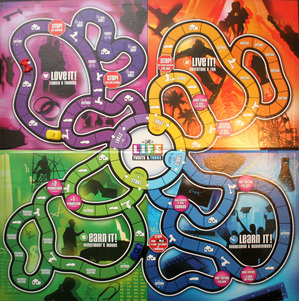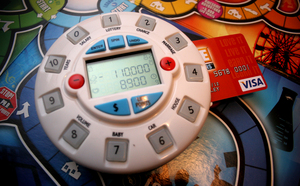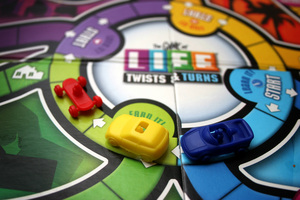Twists and turns make Life exciting

The Life: Twists and Turns boards allows players to choose the route they take around the board rather than being railroaded down a single path like the original version.
Mike Hulsebus | Contributor
Before I take a look at a heavier game next week, I wanted to look at The Game of Life: Twists and Turns edition, the far-superior remake of The Game of Life. You have to be willing to give up Life's spinner and the satisfaction of putting the little peg people into the cars, but it's worth it.
Unlike the original Life, Twists and Turns allows players to choose the direction their life will take. The board is divided into four segments: Marriage, Adventure, Education and Career (or as they call them: Love it! Live it! Learn it! and Earn it!), and players move clockwise around the board choosing whatever route they want to take.
Instead of a spinner, you have an electronic, Visa-branded spinner that takes care of players' current life status. I'm not really a fan of electronic board games, but I'm in favor of this spinner for how it allows the board game to be simple yet complicated. See, each section of the board scores players life points in different ways, and without the electronic spinner, the game would get bogged down with record keeping.
Marriage: Gives players a fixed number of life points per turn. Players that have kids will see them sapping a percentage of their income in favor of earning more life points
Career: Allows players to earn promotions in their chosen field, raising their salary. Money is converted into life points at the end of the game. Adventure: Allows players to earn a quick, one-time bonus of life points. Education: Some careers require the players have degrees in order to earn certain promotions.
The game's "life pod" takes care of all the fiddly parts of the game so that players' turns are quick and easy.
Mike Hulsebus | Contributor
So each turn, the spinner adds your salary, subtracts interest if you have negative income, adds net value to your home, depreciates your car in value, adds life points for being married, removes money for the number of children you have and generates your “roll” for the number of spaces you move. If players had to keep track of this, it would involve a lot of math and record keeping. Instead it is all saved in the electronic spinner.
What I like about the game is that the first times you play it, you find yourself saying “Let's play that again; I want to see if I can win by having eight kids” or whatever other strategy you come up with. The game allows adults to play the numbers and try to maximize their life points while allowing kids that may not care to still have the fun of making up a life story for themselves. If they want to make it to the top of the fashion industry without worrying about what's happening, they can. Basically, this can be a simple game like the original game of Life, or it can be more complex if you want to play the numbers.
When we first got the game, we played it a lot, but it has since fallen out of favor because we have figured it out: Money is the one important thing, especially if you choose to play the longer game. While it varies each game, money is worth, on average, one life point for every $100 you end the game with. So if you can build your job to where you are making $2,000,000 per turn, you are earning approximately 20,000 life points. Compare this to being married which earns you 1500 life points per turn, and you realize why the game becomes a quest to see who can spend the most turns at their maximum salary.
As a result, we've house-ruled career selection and don't play 30-turn games anymore to make sure that it isn't possible to reach the top of rung of the career ladder each game.

While the peg people are gone, players still get the satisfaction of being able to upgrade their starting skateboard into their choice of two cars.
Mike Hulsebus | Contributor
The spinner also has a problem with it. If you choose to buy the fast car, you are supposed to go an extra three spaces each turn. However, the spinner only goes from 1-10: so instead of spinning 4-13 each turn, when a player rolls 8, 9, or 10, it seems to get converted to a roll of a 3, meaning players that buy the faster car find themselves rolling 3-10 with a frustrating abundance of 3s.
For a mainstream game, I like Twists and Turns and would readily choose to play it over many of the other games they sell at Meijer. It's not something that I want to play regularly, but it's still fun to get out and play from time to time. I think it would play well with both kids and adults, though it would likely play best in groups of all kids or all adults so that each can play how they want without adults having to go easy on younger kids. Still, in mixed groups, I think parents could still amuse themselves by trying to win in atypical ways.
Join me next week as we look at one of my favorite games: Arkham Horror, a game that takes a few hours to play. In the mean time, if you had to pick a game from Meijer to play, what would you pick? Let me know in the comments.
Mike reminds you that the most important strategy tip for electronic games is to make sure that you don't accidentally flip them off eight turns in. If you want to boast about beating his record of eight kids in one, 20-turn game, he can be reached at mikehulsebus@gmail.com.


Comments
Mike Hulsebus
Tue, Apr 20, 2010 : 2:24 p.m.
I just found some great graphs that someone made showing just how many 3's the "fast" car gets. In the end, they get about the same average roll http://www.boardgamegeek.com/article/3309731#3309731